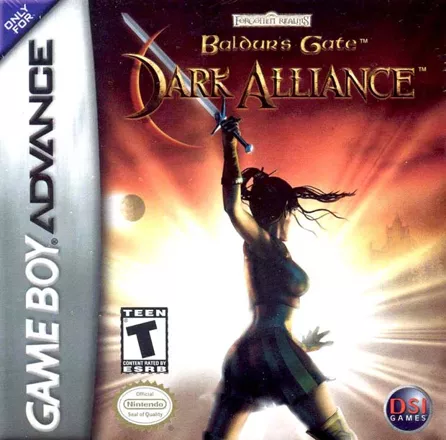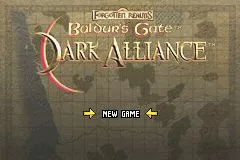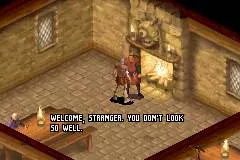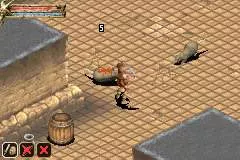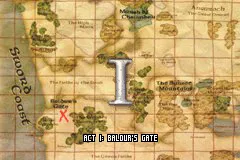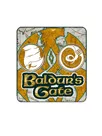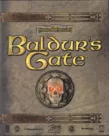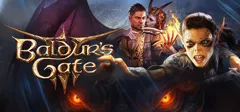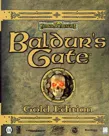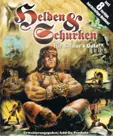Baldur's Gate: Dark Alliance
-
 Baldur's Gate: Dark Alliance
(2001 on
PlayStation 2, 2002 on
Xbox,
GameCube...)
Baldur's Gate: Dark Alliance
(2001 on
PlayStation 2, 2002 on
Xbox,
GameCube...)
Description official description
This version of Baldur's Gate: Dark Alliance follows the same story and has many gameplay similarities to the console release, but also differs from it significantly in presentation and gameplay features.
Due to the limitations of the handheld platform, the game uses an isometric perspective with two-dimensional graphics. It retains the action RPG gameplay system of the console version; however, in this release, the player character is unable to jump.
The player is only allowed to control a human character in this version (as opposed to the pre-made human, elf, and dwarf characters of the console release). The player can still choose to assign the human hero to one of the three available classes: warrior, archer, and wizard.
Other differences include the addition of a few side quests, and an enhanced level of interactivity in the city of Baldur's Gate (the characters are able to enter more houses, talk to town inhabitants, break barrels with equipped weapons, etc.).
Groups +
Screenshots
Reviews
Critics
Average score: 73% (based on 17 ratings)
Players
Average score: 3.4 out of 5 (based on 17 ratings with 1 reviews)
A nice effort, but not quite there yet.
The Good
The graphics are nice overall, and animations are fluid. The character system is easy to learn and combat is generally fast-paced. Different types of equipment allow for different strategies against enemies.
The Bad
While pretty, scenarios are repetitive. The weak storyline with cardboard characters comes off as a mere afterthought. Combat is too simplistic, and considerably brought down by very poor AI. The game also suffers with some balance and design issues.
The Bottom Line
Prelude of ports
It's a wonder why dungeon crawlers, or hack'n'slash games, aren't more prolific in the Game Boy Advance library. These types of games tend to draw players with elements such as manageable, fast combat; the RPG-like layer present in character customization; and the sense of character growth via accumulating increasingly better equipment. Not only that, they’re only as short or as long as players want them to be. It’s just as possible as it is rewarding to play for a handful of minutes or a handful of hours. After all, games like Diablo or Gauntlet have succeeded over the years with this kind of gameplay backing them up.
Maybe for that reason, Destination Software, Inc. teamed up with developer Magic Pockets to release a port of Snowblind and Black Isle’s original 2001 multi-console title released by Interplay, Baldur’s Gate: Dark Alliance for the GBA. For those unaware of the title, it was a hack’n’slash variant of Interplay’s successful CRPG, developed by Bioware and Black Isle, set in the popular pen-and-paper role-playing game Dungeons & Dragons. Unlike the PC original, Dark Alliance shed several of the game’s elements and basically took the same name and setting to present players with an action-oriented game with only a handful of RPG elements.
As expected, the GBA version is different from the PlayStation 2 game of the same name. The design had to be somewhat cut back and fitted into the more limited system hardware, but even so the team did manage to present heartfelt attempt at converting it. However, it turns out to be a less than stellar dungeon romp which has a crippling time gap between its older counterparts.
A tale no bard can save
Story exposition tends to be fairly light in dungeon crawlers, and it’s no exception in Baldur’s Gate: Dark Alliance. The game follows the same path as its other console counterparts by basically putting players in the role of a nameless adventurer who has been robbed and left unconscious when arriving at the city of Baldur’s Gate. This minor event sets the motions for a much larger series of situations, and what begins as an attempt to right the wrong committed against you ends up becoming a predictable story of war, treachery and betrayal that unfolds as you progress trough the game’s three chapters as the hero.
This formulaic setup isn’t very appealing. While some stories manage to be engrossing even if built on previously established ideas or even cliches, here it just feels like an afterthought. You won’t feel attached to the characters you encounter, and whatever their stories and plights may be, you’ll get the feeling it’s all too artificial and simply there to move along the game. It’s obvious whatever shred of a story there is in Dark Alliance is only there to keep things going and to give an ulterior motive to the players, and in that regard it works, but this is yet another game which has a forgettable troupe of characters and a bland story we’ve all seen much better told elsewhere. The stationary sprites and the never ending short bursts of text don’t help in captivating players, either.
I am what I am
Thankfully, there’s more to the game than the story. Dark Alliance is a hack’n’slash game after all, and as such some of the most fun parts of the game come from fighting your way trough levels and exploring every area in search of the Next Big Thing in terms of gear and fighting enemies to gain experience points to level up, and from customizing your character.
The later is initially weak, however, with only a selection of available classes at the beginning. While the classes remain, the different races and gender of the game have been removed in this port, and replaced with a male human as the only available race for the main character, with cloth colors and class names being the main difference between available avatars. At the beginning of the game, you just select one class and the game starts right away. As expected, each class excels at different things. Fighters work best in close range, Archers from a distance, and Wizards have various spells to work with, allowing them to get as close or as far as necessary.
Character customization made by the player is only achieved at level up. Whenever a player gains a certain amount of experience points, a floating text will warn the player that the character has reached a new level of experience. Each level grants automatic increases to your preset attributes such as Strength and Dexterity, and every four levels you’ll be able to spend an additional point in an attribute of your choice. These attributes have bonuses associated to them. You’ll notice characters with a high Dexterity attribute have a better chance to hit opponents with ranged weapons and have a better Armor Class, while characters with a higher Wisdom will earn more experience points when they kill monsters and perform quests.
Also at level up, you will earn bonus points which can be spent in improving or acquiring new skills. Skills are divided into two groups, Active and Passive. Active skills are skills which need to be activated in order to work, and these vary from class to class: for instance, a Fighter will be able to use Combat Aura, which grants a bonus to Strength, while the Archer may use Hail of Arrows to fire a heavy barrage of arrows against his foes, but these attacks must be triggered by the player while in combat. Passive skills, on the other hand, are skills common to all classes that work in the background. As an example, you’ll get the chance to upgrade a skill called Dodge, which grants a bonus to your Armor Class when it comes to dodging the attacks of foes, or Endurance, a skill which grants added carrying capacity.
Of note is another part of customization, equipment. Most of the equipment the character finds will be seen when equipped. So when you equip a sword and a shield, the character will hold both, quickly changing into a sluggish stance whenever holding a two-handed weapon like a battle axe. However, this is merely a reflex of the equipment you are wearing, and the changes aren’t that interesting: while the avatar represents weapons equipped fairly well (you’ll see the character is wearing a scimitar by looking at the curved edge of the blade as opposed to the straight, shorter blade of a medium-sized sword), all the armor pieces will only change in color, remaining largely non-descript.
I've been here before
As you advance in the game, you will encounter a fair number of different creatures, as well as equipment lying around or dropped by those same creatures, as you travel trough various scenarios. While you will spend the initial stage of the game in the sewers that lay beneath the city of Baldur’s Gate, you’ll eventually travel trough other cities, dungeons, forests, and caves, killing enemies and collecting items.
The equipment you find in Dark Alliance is fairly varied: you’ll go from rusty daggers, enchanted swords, and powerful warhammers to shields, sturdy armor pieces and magical accessories. You’ll come across better and better items as you go along, selling the outdated equipment to shopkeepers in order to lighten your load while saving up for that shiny platemail you saw earlier, or those potions for a difficult combat situation. These items, while no doubt helpful to adventurers, will eventually become redundant, and often players will just look at the damage numbers and sell anything that’s inferior to it.
This leads to a problem in the game. Most games of this type give players the means to travel back and forth between cities and combat areas quickly so as to keep the pace of the game. Some games use items that allow players to return to nearby cities or places which have shops of sorts, much like a Stone of Recall or Scrolls of Town Portal in Neverwinter Nights or Diablo 2, respectively. Here, a similar option is not available. While it’s expected that some dungeon crawls have a certain level of backtracking to sell items, it’s also expected to be some options to make this travelling less boring and time-consuming than it should be.
Games like Dungeon Siege or Fate solve this problem by having companions who can hold on to items for you, and even the other versions of Dark Alliance have something called Recall Potions (which enable the player to travel back to safe areas), but here you’re playing solo, with an inventory limited by your Strength attribute (as it determines how much you can carry), and unable to quickly jump in and out of the field of battle. This makes it so spellcasters who focus more on spellcasting attributes might need to spend additional time running back and forth large levels just to sell a meager amount of equipment which they cannot carry very well, but overall this is a nuisance.
Another problem in this is that you may find yourself halfway trough a dungeon with a filled inventory, unable to carry anymore items. When you attempt to return to a shop, you’ll need to travel back to the dungeon’s starting point, which wouldn’t be a problem in itself, except enemies respawn when you leave and re-enter an area. This means that if you want to leave to sell items, you’ll have not only to dispatch enemies you killed before but will also need to choose between items, or completely ignore items slain enemies may drop if you cannot carry anymore loot.
This is just one of the things that make the dungeon crawling aspect a bit tedious when easy workarounds would be very much possible. Another one is the sprite limitation on screen. Perhaps due to the quality and size of the sprites, you’ll rarely get more than five enemies on-screen simultaneously (five or more sprites and you might notice some lag, even), taking away the life out of some areas, such as underground complexes or a supposedly bustling city.
A feature that strangely is nowhere to be found is a minimap. Initial areas aren’t that big, but some of the mid to later stages are large and expansive, and the repetitive backgrounds can confuse players as to wheter they have been there before or not. The addition of a minimap would likely help in those situations, and it could even go hand in hand with the area resetting that occurs when you leave and enter an area, to avoid making it too easy.
I hack, you slash
Players have a choice of melee weapons, ranged weapons or spells or spell-like abilities to use in Dark Alliance’s combat, which can be toggled in the middle of the action. A trio of icons in the lower left corner shows what kind of attack you have selected at the moment, though truthfully this isn’t very needed, considering the character will visibly wear items which players will be able to recognize as specific to which attack group. Nonetheless, it’s a handy quick reference should the need arise.
But while easy to get into and get along with, combat is another feature of importance to the game that gets a poor treatment. Combat is, for the lack of a better word, disappointing.
Players can attack and parry, but they can only attack with each press of the attack button. This makes it so combat isn’t terribly exciting since most of the time all you are doing is hitting a button until some critter falls dead or hitting a button to block. Something like attack combos could definitely perk up the combat, but these are non-existent, and you’re just left with very basic combat options. Speaking of blocking, your character is able to block nearly everything directed at him, from melee to ranged to magical damage thrown at him. This makes it so a player can just effortlessly block incoming attacks and take that time to his advantage, like letting his health regenerate, with no danger.
Enemies aren’t better suited, either, as they can only attack. They never defend at all. And that is just a small problem with them. Possibly the worst offender when it comes to combat is the enemy AI. Enemies have very little sense of tactics or their environments. Melee-based enemies will gladly rush against you even if it means getting into the line of sight of their ranged-based cohorts, or passing non-stop trough a hallway with fire-spitting statues that burn them. The very few enemies that use spells of sorts against you will kill off their own associates most of the time – you’ll feel frustrated trying to kill an enemy only to see it topple due to your own opponent’s attacks. Enemies just seem to focus on the player and either run to him or attack him from afar neglecting everything else. Wounded or nearly dying enemies don’t run nor do they heal themselves. An enemy that is attacking you in the front may suddenly stop doing so in order to position itself in a slightly different position because a nearby enemy is attacking you from the back.
To make matters worse, enemies tend to have their own designated areas of movement. This means that many enemies will not chase you around, and instead will ‘patrol’ their areas, chasing you to the invisible limits of said areas and then returning to them when you are out of sight or reach. At first one would attribute this to large enemies not being able to pass trough large doors, but it happens with smaller or medium-sized enemies as well, even when they are placed in large areas. This makes it so players can attract enemies into these borders, then from a safe distance pelt them either with melee or ranged attacks until they leave to their initial positions, at which point players can repeat this ad nauseum. Gaining experience trough this kind of exploitation is up to players, but still, it’s a problem that should have been noticed and corrected.
Balance also comes out a bit weird in several areas. Swords, for instance, are the undisputed melee weapons in the game with the better features and damage outputs (it comes as no surprise the ultimate melee weapon found in the game is, in fact, a sword), so it’s not uncommon to find players that play Fighters to sell most other types of weapons. There are other very good weapons, true, but high damage dealing weapons is where players will focus on. Another problem is with shields – with a very small point expenditure in a certain skill, players will be able to use large, two-handed weapons as shields, blocking attacks directed at them. Given they can carry a weapon with a large damage output that can also be used to defend, this will likely make many players opt for a single large, melee weapon to carry around and dump the one-handed weapon and shield combo. A way to make either one just as appealing, instead of making one option more attractive than the other, would be nice.
That game you play
For the most part, the game does sport some fluid (even if repetitive) animations, and the size of the sprites helps players see creatures in a new light. Undead stumble about, rats pounce against you, giants stand erect and swing their mighty swords at you, while Umber Hulks move menacingly at you. Likewise, weapons are very well done, each giving off their distinct feeling when equipped. It might’ve been interesting to add special effects to weapons, though: since all weapons of a given weapon group share the same sprite, you’ll never guess if the weapon you’re using is a magical or standard one, if it has fire or cold enchantments, or what material its made of. Things like a red tint indicating fire properties, or small blueish pixels falling off the blade like snow suggesting cold enchantments would provide much better feedback here.
The environments are also nicely drawn, even if they are a bit bleak and uninteractive. One quibble with the game's isometric perspective is that walls do not fade out when the character passes behind them, which means players can't really see what is happening there and characters just get obscured by the scenery. Either the player hacks away until he hears a critter die or he lures them out and into a better field of vision. If an enemy drops an item behind a wall, you'll have to move around until you see a standard message asking you if you want to pick up an item. Not game-breaking, but potentially annoying.
While graphics work very well, sound, however, is worse. While sound effects are nice, music ranges between minimal chords or looped sequences which don’t add anything worthwhile to the atmosphere. If you’re expecting to hear epic songs when confronting hordes of enemies or end level bosses, think again.
Replayability is also lacking. Unless you have a burning desire to try out different strategies with the different classes, there’s no real reason to bother replaying as the game generally plays, and ends, the same. In fact, the first time you finish the game you will unlock a secret class, the Elven Fighter (likely the Drizzt Do’Urden version of other versions), who has select abilities from all other classes. So you can restart the game with that class and get a taste of what it feels like playing with all others.
Unfortunately, the option to explore this gameworld with a fellow gamer has been left out of this conversion, making the experience quite a bit more lonesome.
Final Words:
While it’s admirable that Magic Pockets managed to include much of what made Dark Alliance a hit on other consoles, it still falls short on many ways. The gameplay is significantly slower paced due to the limitation of the on-screen amount of simultaneous sprites, the repetitive back tracking required to sell excess gear, and the overall poor combat. A deeper combat system, some much needed huge tweaks to the AI, and several improvements to the game’s structure and design would go a long way in making this game a must buy.
But as it stands you can safely ignore it and expect the cliffhanger presented at the end of the game is a sign that a (better) sequel is coming.
Game Boy Advance · by Diogo Ribeiro (332) · 2005
Analytics
Upgrade to MobyPro to view research rankings!
Identifiers +
Contribute
Are you familiar with this game? Help document and preserve this entry in video game history! If your contribution is approved, you will earn points and be credited as a contributor.
Contributors to this Entry
Game added by Unicorn Lynx.
Game added June 10, 2011. Last modified February 22, 2023.
